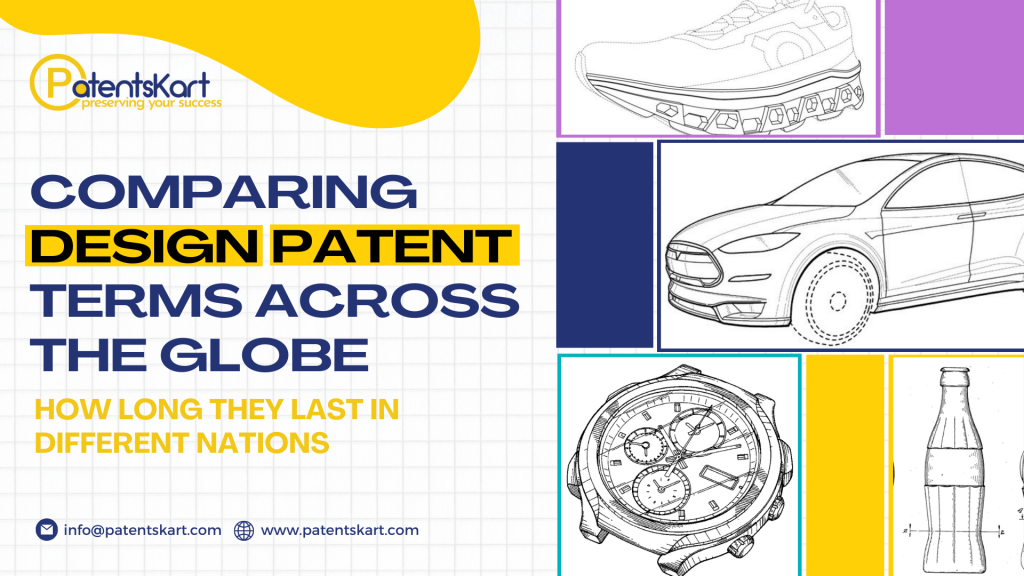When it comes to intellectual property, design patents play a crucial role in protecting the unique visual appearance of products. However, the duration of design patent protection varies from one country to another. If you’re an inventor or a business owner seeking international design patent protection, understanding these differences is essential. In this blog, we will compare design patent terms across the globe to help you make informed decisions.
United States – 15 Years from the Date of the Grant
In the United States, design patents last for 15 years from the date of grant. This means that once your design patent is granted, you have exclusive rights to your design for a period of 15 years. You can find more information on design patent duration in the United States here.
European Union – 25 Years with Renewal
In the European Union, design patents are granted for 25 years, provided that the owner pays the renewal fees. This longer duration can be beneficial for businesses looking to protect their designs in the EU market. For more details, you can refer to Patworx.
China – 15 Years from the Date of Filing
China offers design patent protection for 15 years from the date of filing. It’s worth noting that this duration is calculated from the filing date, not the grant date. For more information on design patents in China, you can visit Legal 500.
Japan – 25 Years from the Date of Filing
In Japan, design patents last for an impressive 25 years from the date of filing. This provides substantial protection for innovative designs. You can find more about design patents in Japan on the Japan Patent Attorneys Association website.
South Korea – 15 Years from Date of Registration
South Korea offers design patent protection for 15 years from the date of registration. This means that as soon as your design is registered, you have exclusive rights for 15 years. For additional details, visit Flat Fee Corporation.
India – 10 Years from Date of Registration
In India, design patents are valid for 10 years from the date of registration. This shorter duration may require patent holders to consider timely renewals or seek additional protection through other means. You can learn more about design patents in India here.
United Kingdom – Up to 25 Years with Renewal
The United Kingdom offers a unique approach to design patent protection. The initial period is 5 years, but it’s renewable in subsequent 5-year periods, up to a maximum of 25 years. This flexibility can be advantageous for those looking for long-term protection. Further information can be found on the UK Government website.
Germany – Up to 25 Years with Renewal
Germany follows a similar pattern to the UK, providing design patent protection for up to 25 years with the option for renewal. This extended protection can be crucial for businesses in the German market. For more details, you can refer to IIPLA.
Canada – 10 Years from the Filing Date
In Canada, design patents last for 10 years from the filing date. It’s important to note that the clock starts ticking from the date you submit your application. More information on Canadian design patents can be found here.
Australia – Up to 10 Years with Renewal
Australia offers design patent protection for 5 years initially, with the possibility of renewal for up to 10 years in total. This allows patent holders to adapt to changing market conditions. You can explore more about Australian design patents on IP-Coster.
Brazil – 10 Years with Possible Extension
In Brazil, design patents are valid for 10 years from the filing date, with the possibility of one extension for an additional 3 years. This extension option can be valuable for businesses. You can learn more about design patents in Brazil here.
Russia – Up to 25 Years with Extension
Russia offers design patent protection for 5 years, with the possibility of extending protection for up to 25 years in total. This extension flexibility can be advantageous for those interested in the Russian market. For further details, you can refer to Sojuzpatent.
France – Up to 25 Years with Renewal
In France, design patents are valid for 5 years initially, with the option to renew for four additional periods of 5 years each, up to a maximum of 25 years. This allows for the long-term protection of your designs. You can find more information on French design patents here.
Switzerland – Up to 20 Years with Extension
Switzerland offers design patent protection for 5 years initially, with the possibility of extending it for three additional periods of 5 years each, up to a maximum of 20 years. This extension option can be useful for businesses operating in Switzerland. For additional details, visit Rentsch Partner.
South Africa – 15 Years with No Renewal
In South Africa, design patents last for 15 years from the date of grant, with no option for renewal. This straightforward duration can be beneficial for businesses seeking design protection in South Africa. You can find more details here.
New Zealand – Up to 15 Years with Renewal
New Zealand provides design patent protection for 5 years from the date of registration, with the option to renew for further periods of 5 years, up to a maximum of 15 years. This renewal option can be valuable for businesses looking to protect their designs in New Zealand. You can learn more about New Zealand design patents here.
Mexico – Up to 10 Years with Renewal
Mexico offers design patent protection for 5 years, renewable for one additional period of 5 years. This renewal option allows for up to 10 years of protection in total. More details can be found on IP-Coster.
Singapore – Up to 25 Years with Renewal
Singapore provides design patent protection for 5 years, with the possibility of renewal for up to four additional periods of 5 years each, up to a maximum of 25 years. This flexible renewal option can be advantageous for businesses in the Singaporean market. For further details, visit IPOS.
Turkey – Up to 25 Years with Renewal
In Turkey, design patents are valid for 5 years, renewable for four additional periods of 5 years each, up to a maximum of 25 years. This renewal flexibility can be crucial for businesses with long-term plans in Turkey. For more information, you can refer to Turk Legal.
Argentina – Up to 15 Years with Renewal
Argentina offers design patent protection for 5 years initially, with the option to renew for two additional periods of 5 years each, up to a maximum of 15 years. This renewal flexibility can be beneficial for businesses operating in Argentina. You can explore more about design patents in Argentina here.
Chile – 10 Years from Filing Date
In Chile, design patents last for 10 years from the filing date. It’s essential to track the filing date to ensure timely renewals if needed. For more information on design patents in Chile, you can visit Lloreda Camacho & Co.
In conclusion, the duration of design patents varies significantly across different nations. When seeking international protection, it’s crucial to be aware of these differences and plan accordingly. Performing a comprehensive design patent search is an integral part of this process. Whether you are interested in the European Union with its 25-year protection or South Africa with its straightforward 15-year term, understanding the nuances of design patent terms will help you make informed decisions and safeguard your creative innovations on a global scale.
Also Read: The Future of Patent Research Services: Emerging Trends and Innovations to Watch Out for







